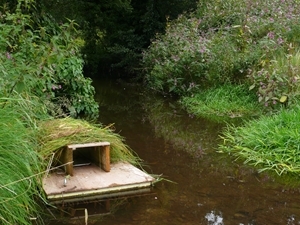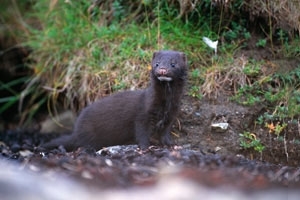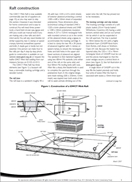Contents
 The GWCT Mink Raft was developed both as a means of detecting mink, and as a favourable trap site. In pilot work in 2002, we found that it was a far more sensitive way to detect the presence of mink than speculative trapping, local knowledge or systematic searches for field signs.
The GWCT Mink Raft was developed both as a means of detecting mink, and as a favourable trap site. In pilot work in 2002, we found that it was a far more sensitive way to detect the presence of mink than speculative trapping, local knowledge or systematic searches for field signs.
The raft was conceived primarily as a research tool and we continue to use it to develop strategies for managing mink in a UK conservation context. But the raft is also a key feature of those improved strategies. The advantages of a raft-based control policy have been quickly recognised by conservation bodies throughout the UK, and it now forms the basis of many conservation projects, both local and large-scale.
In 2005, the GWCT Mink Raft won the first ever Wild Animal Welfare Award offered by the Universities Federation for Animal Welfare, in recognition that it led to a more focused form of control with greatly reduced animal welfare costs.
This guide explains how mink rafts are constructed and used, and the range of associated services offered by the Trust. All the topics covered here (and more) are covered in depth at our mink raft training workshops, which can be arranged at a venue and date of your choice.
The GWCT Mink Raft is supported by a considerable body of research done by the Trust, which is ongoing. During this research, we have seen no reason to change the original design except in a couple of minor details. Inevitably, though, a number of variant rafts have sprung up in other projects. To what extent our research findings also apply to such variants is unknown. You deviate from the well-researched design described here at your own risk.
What is the GWCT Mink Raft?
 The GWCT Mink Raft is a simple, cheap, low-tech device that improves on previous mink control practices in almost every respect. It encourages mink to leave evidence of their presence in the form of footprints. The raft uses a standardised mixture of clay and sand to record the tracks over a period of 1-2 weeks.
The GWCT Mink Raft is a simple, cheap, low-tech device that improves on previous mink control practices in almost every respect. It encourages mink to leave evidence of their presence in the form of footprints. The raft uses a standardised mixture of clay and sand to record the tracks over a period of 1-2 weeks.
The tracking medium is problem-free and provides unequivocal evidence of mink presence. Once a mink is detected, the raft(s) on which it left its tracks also becomes the best place to set a trap. The commonest result is that the mink is caught next day.
The raft has two modes of action: monitoring and trapping. In use, it spends most of its time in monitoring mode, and reverts to monitoring after each brief spell of trapping. In monitoring mode, the raft records the footprints of any visitors (from water shrews to otters), and can be left to accumulate such evidence over a period of one to two weeks. The idea is to set traps only on rafts that have recorded evidence of mink within the last check period. The mink will then usually be caught within a few days.
After running the trap for a maximum of seven to ten days, the raft is returned to monitoring mode, to establish whether there is still a mink to be caught. In this way, the mink control effort becomes self-assessing, and it is easy to see whether trapping is effectively controlling mink numbers.
Training workshops
We offer one-day workshops or refresher courses for conservation bodies engaging in mink control. The workshops can be tailored to your requirements from the topics listed below, and are suited to everyone including decision-makers and practitioners, professionals and volunteers. You choose the location and the emphasis you require.
Topics available include:
- The history of mink and mink control in Britain
- Is mink control necessary? The evidence linking water voles to mink
- The GWCT Mink Raft: A logical approach that leads to focused, incisive mink control
- Mink traps: Recognising good and bad traps
- Mink trapping on land
- Planning and budgeting for mink control
- Ethics
- Humane dispatch and related safety and legal issues
- Health and safety, risk assessments
- Water vole reintroductions
- Hands-on practical outdoor session: How to deploy and maintain the mink raft, handling the mink in the cage, humane dispatch
- Gun safety
Our workshops offer you the very best instruction from the experts, based on a long history of involvement in predator management, richly supported by research data and fully up to date. To book please contact our advisory department on 01425 651013 or email advisory@gwct.org.uk.
Please keep in touch
If you are planning to use the GWCT Mink Raft, please get in touch with us. Mink are a difficult issue for everyone and we are keen to see management methods developed that are both effective and appropriate. Until we have a clear evaluation of what it takes to achieve particular conservation goals, none of us can decide what is feasible and reasonable.
Intensive research of the kind done by the GWCT, WildCru (Oxford University) and Aberdeen University has a crucial role here to gain unequivocal answers to specific questions. But ultimately the real test of any approach is in actual use. By co-ordinating practical trials across the country, we can turn locally applied effort into a collective learning experience.
Get your FREE Mink Raft Plans today
 The award-winning GWCT Mink Raft was developed both as a means of detecting mink, and as a favourable trap site.
The award-winning GWCT Mink Raft was developed both as a means of detecting mink, and as a favourable trap site.
What you can download for free
✓ Mink Raft Guidelines
✓ Instructions & Plans
✓ How to Build the GWCT Mink Raft
Download now >